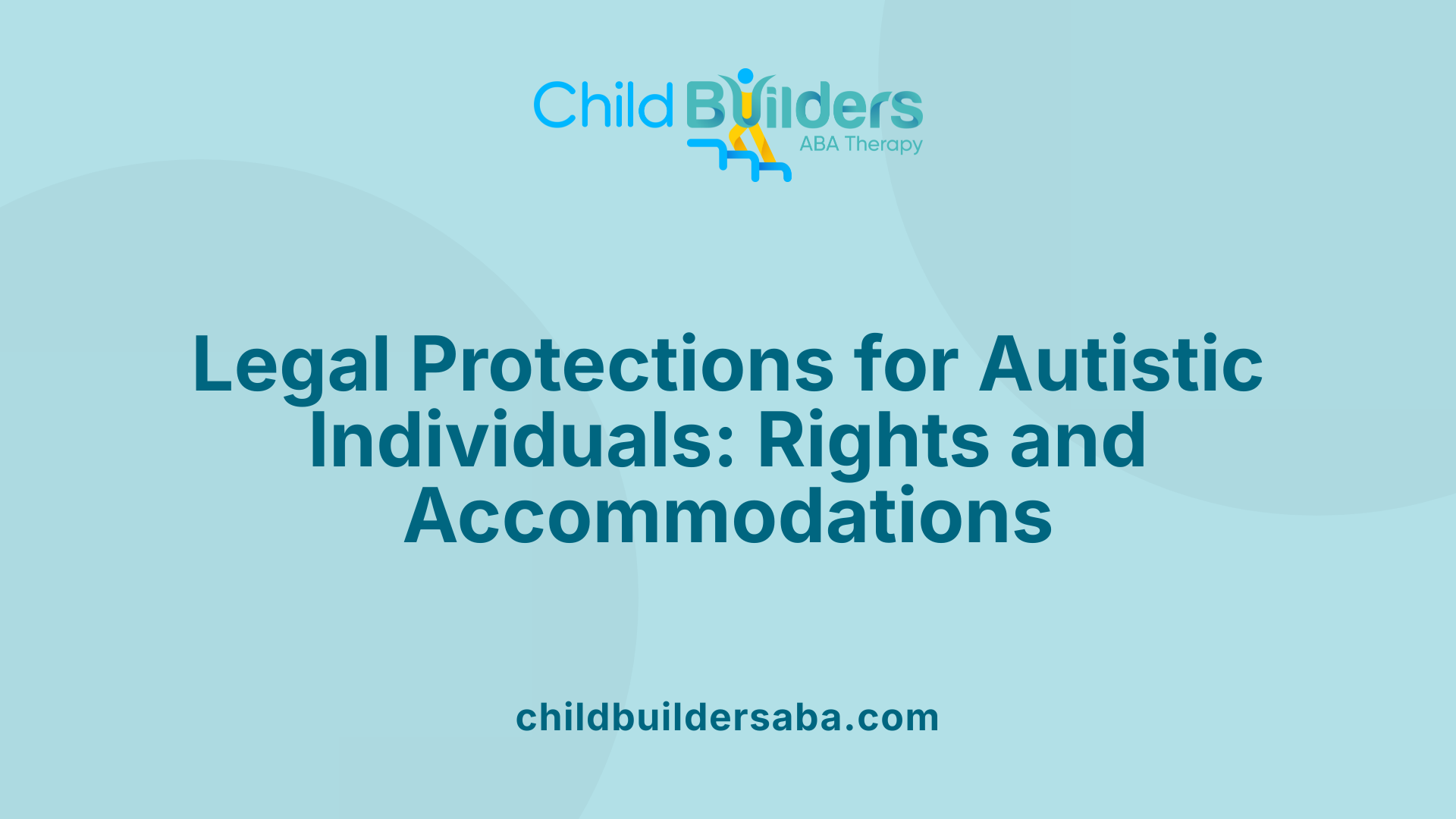Is Autism A Disability?

Unraveling the Nature of Autism and Its Classification
Autism, also known as Autism Spectrum Disorder (ASD), is a complex neurodevelopmental condition affecting millions worldwide. Its classification as a disability has profound implications for legal rights, societal perceptions, and support systems. This article explores the characteristics of autism, its recognition as a disability, and the legal, medical, and social frameworks that define and protect autistic individuals.
Overview of Autism Spectrum Disorder (ASD) and Its Symptoms

What are the main symptoms of autism spectrum disorder?
Autism spectrum disorder (ASD) presents with a variety of behaviors and traits that can differ significantly among individuals. The primary symptoms typically include challenges in social communication and interaction. Many autistic people find it difficult to make eye contact, interpret facial expressions, and understand social cues like tone of voice or body language. This can make forming and maintaining relationships more challenging.
Children with ASD often show delayed speech development or may never develop spoken language at all. They might respond to their name inconsistently or appear not to hear when spoken to. Repetitive actions, such as hand-flapping, rocking, or spinning objects, are common. Many individuals develop routines or rituals that help them feel secure and may become distressed if these routines are disrupted.
Intense interests or fixations on specific topics or objects are also typical. For example, a person might focus obsessively on trains, numbers, or specific video games. Sensory sensitivities are prevalent; some individuals are overly sensitive to sounds, lights, textures, or smells.
These symptoms generally emerge between ages 2 and 3, but some signs can be observable earlier or later depending on the person's development. Recognizing these behaviors early can lead to timely diagnosis and intervention, which significantly supports development and quality of life.
How is ASD diagnosed?
The diagnosis of ASD involves comprehensive evaluations by trained professionals, including developmental and behavioral assessments. No single medical test or blood work can conclusively diagnose autism. Instead, clinicians observe behavior, gather developmental history, and assess communication skills.
Tools like the Autism Diagnostic Observation Schedule (ADOS) and Autism Diagnostic Inventory-Revised (ADI-R) are commonly used. These assessments help identify deficits in social interaction, communication, and repetitive behaviors.
Early diagnosis is crucial because early intervention can make a meaningful difference, improving social skills, communication, and behavioral flexibility over time.
In what ways can individual experiences vary?
ASD is a spectrum disorder, meaning there is wide variation in how traits are expressed and the degree of support needed. Some individuals might have high cognitive abilities and speak fluently, while others are nonverbal and need significant assistance.
Support needs can range from minimal to extensive, depending on the person's unique profile. While some may excel in specific areas like math or music, others might face substantial obstacles in daily functioning.
Understanding this diversity is essential for providing appropriate supports and fostering acceptance of each person's unique strengths and challenges.
| Aspect | Variability | Examples |
|---|---|---|
| Communication | From fluent speech to nonverbal | Reading books aloud, using sign language |
| Social Skills | From occasional social interaction to significant difficulties | Playing with peers, understanding social norms |
| Repetitive Behaviors | From mild routines to intense fixations | Spinning objects, collecting items |
| Sensory Sensitivities | Mild discomfort to overwhelming reactions | Covered ears, avoiding certain textures |
| Support Needs | From minimal accommodations to extensive assistance | Personalized therapy plans, educational supports |
Defining Autism as a Disability and Its Core Characteristics

Is autism classified as a disability or a disorder?
Autism is classified as a neurological developmental disability. Medically, it is known as autism spectrum disorder (ASD), which reflects the broad and varied range of symptoms and levels of impairment seen among individuals.
From a legal perspective, many countries, including the UK and the US, recognize autism as a disability. Laws such as the Americans with Disabilities Act (ADA) affirm that autism qualifies as a disability because it significantly affects one's ability to communicate, interact socially, and perform daily tasks.
Despite its technical classification, some autistic individuals may not identify as disabled, viewing their traits as part of their identity. Nonetheless, autism is a lifelong condition that impacts how people experience the world, often necessitating supports and accommodations.
Spectrum nature and individual variability
Autism is not a one-size-fits-all condition. It is best understood as a spectrum, meaning each person with autism has a unique combination of characteristics.
Some might have advanced communication skills, while others are nonverbal. Likewise, the extent of social challenges, sensory sensitivities, and repetitive behaviors varies widely.
This diversity underscores why autism spectrum disorder encompasses a wide array of experiences. It underscores the importance of personalized approaches in support, education, and employment accommodations.
| Aspect | Variation | Implication |
|---|---|---|
| Communication skills | Highly verbal to nonverbal | Support needs vary from speech therapy to alternative aids |
| Social interaction | From social confusion to relatively typical interactions | Accommodations and social skills training may be needed |
| Repetitive behaviors | Rigid routines to mild preferences | Intervention strategies differ based on severity |
Understanding autism as a spectrum emphasizes its wide-ranging impact and the importance of recognizing individual differences when providing support or planning accommodations.
Legal and Social Recognition in Policy and Society

Is autism recognized as a disability for benefits and legal protections?
Yes, autism is officially recognized as a disability that qualifies individuals for various legal protections and benefits. In the United States, autism appears in the Social Security Administration’s (SSA) Blue Book, which lists conditions eligible for disability benefits. For children, autism is listed under section 112.10, and for adults, under section 12.10. This classification confirms that individuals with autism can apply for Social Security Disability Insurance (SSDI) or Supplemental Security Income (SSI), provided they meet specific medical criteria demonstrating substantial impairments in communication, social interaction, and daily functioning.
Legal frameworks such as the Americans with Disabilities Act (ADA), Section 504 of the Rehabilitation Act, and the Individuals with Disabilities Education Act (IDEA) reinforce autism’s recognition as a disability. These laws prohibit discrimination in employment, education, and public services, mandating reasonable accommodations for autistic individuals. Importantly, to access benefits or protections, applicants must submit detailed medical documentation like assessments, caregiver statements, and diagnostic reports showing how autism restricts their activities.
This widespread legal acknowledgment supports the inclusion and protection of autistic individuals across different areas of life. It enables access to targeted support services, workplace accommodations, and legal safeguards, fostering a more equitable society that recognizes autism as a legitimate disability.
Life Expectancy and Health Outcomes for Autistic Individuals
What is the life expectancy of a person with autism?
The average lifespan of individuals with autism varies, generally ranging from about 39 to 58 years. Multiple factors influence longevity, including the severity level of autism, co-occurring health conditions, and access to quality healthcare.
Recent research, such as a UK study by O’Nions et al. (2023), indicates that the life expectancy gap between autistic individuals and the general population may be less than ten years. For instance, men with autism often live between 70 and 75 years, while women with autism tend to live slightly longer, around 70 to 77 years.
The level of autism also plays a significant role. Those classified with Level 1 autism—a condition involving fewer challenges—generally have a life expectancy closer to the general population, although still slightly reduced. Conversely, individuals with Level 3 autism, which involves more significant support needs, may have a shorter lifespan, with some estimates as low as 35 to 40 years.
Co-occurring health conditions significantly impact lifespan. Conditions like epilepsy, respiratory issues, and mental health challenges such as depression or anxiety can reduce longevity. Additionally, accidents and injuries are leading causes of early death among autistic individuals.
Early diagnosis, comprehensive medical care, and supportive therapies are essential in improving health outcomes. These interventions can help manage co-occurring conditions and reduce risks, potentially extending life expectancy. Overall, with proper support, many autistic individuals live fulfilling lives and reach old age.
Genetic and Environmental Factors in Autism Development
Is autism genetic?
Autism spectrum disorder (ASD) has a strong genetic component, but it is not caused solely by genetics. Research shows that autism influences and is influenced by a complex interplay of genes and environmental factors.
Many gene variations are associated with autism, including de novo mutations—those that are new and not inherited—and copy number variations, which involve duplications or deletions of sections of DNA. These genetic changes can affect brain development and functioning.
Autism tends to run in families, indicating heritability, but most cases are idiopathic, meaning the precise cause remains unknown. This suggests that a combination of genetic predispositions and environmental influences contribute to the likelihood of developing ASD.
Specific genetic conditions such as fragile X syndrome and Rett syndrome are well-evidenced examples of genetic factors linked with autism. These syndromes often include autism-like features as part of their broader spectrum.
Research findings support the view that genetics play a significant role, yet environmental factors—such as prenatal exposures, parental age, and birth complications—also impact neurodevelopment and autism risk. Additionally, epigenetic mechanisms, which involve changes in gene expression without altering DNA sequences, further complicate how genetics and environment interact.
Overall, the understanding of autism's causes highlights a multifaceted origin where genetic factors are primary but modulated by various environmental influences, making each case unique.
For further insights, search "genetic causes of autism" to explore current research and discoveries.
Implications of Classifying Autism as a Disability
What implications does classifying autism as a disability have for legal rights and protections?
Recognizing autism as a disability plays a crucial role in safeguarding the rights of autistic individuals. Under laws like the Americans with Disabilities Act (ADA), Section 504 of the Rehabilitation Act, and the IDEA, autism is acknowledged as a condition that can limit major life activities, such as communication, learning, and social interaction.
This legal classification grants protections against discrimination in employment, education, healthcare, and public accommodations. Employers and educational institutions are mandated to provide reasonable accommodations, such as flexible work or school schedules, sensory-friendly environments, and support services.
Moreover, acceptance of autism as a disability opens access to vital resources like vocational rehabilitation, health care protections, and social security benefits. It also ensures that autistic individuals are protected from health disparities, including nondiscrimination in health services and accessible communication tools.
Overall, giving autism the status of a disability not only affirms their rights but also promotes equality and participation in all aspects of society, fostering a more inclusive environment where autistic individuals can thrive.
Autonomy, Acceptance, and the Future of Support Systems
Recognizing autism as a disability has profound implications for the rights, protections, and societal integration of autistic individuals. While autism presents unique challenges, understanding its classification enables access to essential support services, legal protections, and broader societal acceptance. As awareness grows and policies evolve, fostering a more inclusive environment that respects neurodiversity remains a collective goal. Ultimately, whether viewed through medical, legal, or social lenses, autism’s recognition as a disability plays a critical role in promoting equality, enabling individuals to lead fulfilling lives, and shaping a more understanding world.
References
- Autism - U.S. Department of Labor
- What is autism - National Autistic Society
- Understanding Disability Benefits: SSDI & SSI for Autism
- About Autism Spectrum Disorder - CDC
- Autism & Disability Benefits | SSI | Lighthouse Autism Center
- Recognizing the Needs of People on the Autism Spectrum and Their ...
- Autism Spectrum Disorder - National Institute of Mental Health (NIMH)
- Is Autism a Developmental Disability? - 3billion
- What is autism? - NHS



.jpg)

































































































